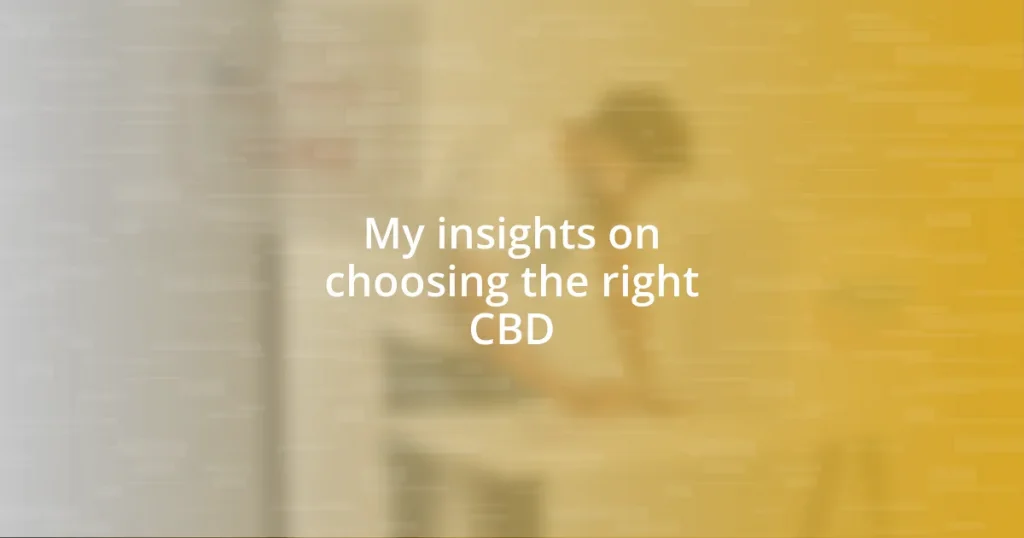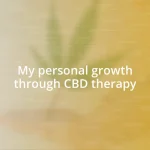Key takeaways:
- Understanding different types of CBD (full-spectrum, broad-spectrum, isolate) is crucial for selecting the right product based on personal preferences and desired effects.
- Third-party testing is essential for ensuring the potency and purity of CBD products, enhancing consumer trust and informed choices.
- Finding the right potency and dosage involves personal experimentation and reflection on how one’s body responds.
- Comparing brands and their unique formulations helps identify the best fit for individual needs and enhances the overall CBD experience.

Understanding CBD Products
When I first encountered CBD products, the variety on the market felt overwhelming. Do you remember the last time you walked into a store and saw endless options that left you questioning which one to choose? That’s exactly how I felt, facing everything from oils and edibles to capsules and topicals. Each form comes with its own set of potential benefits and methods of use.
As I began exploring, I learned that full-spectrum and isolate CBD are two common terms worth understanding. Full-spectrum contains a range of cannabinoids, which may enhance its effectiveness, while isolate offers pure CBD without other compounds. Personally, I found that full-spectrum worked better for me during stressful moments. Have you considered how your body might respond to these different types? It’s fascinating how individual reactions can vary significantly.
Ultimately, it’s essential to know how each product aligns with your personal preferences and lifestyle. Some folks enjoy the convenience of a quick gummy, while others prefer the potency of an oil they can really customize. I’ve often asked myself what would suit me best and, through some trial and error, I’ve discovered that sometimes it takes a little experimentation to find the perfect fit for your needs.

Types of CBD Available
Understanding the types of CBD available can significantly influence your experience. For instance, I remember trying my first CBD oil after hearing about its calming effects. It was such a simple drop under my tongue, yet it opened my eyes to the world of full-spectrum benefits. This type includes not just CBD, but other cannabinoids, which can create what’s called the “entourage effect.” This term refers to the idea that these compounds work better together than alone.
On the other hand, I’ve also experimented with CBD isolate, which is like that friend who prefers to stand out on their own. Isolate contains only CBD, leaving behind other cannabinoids, terpenes, and oils. It’s a fantastic option if you’re looking for purity or are sensitive to THC. I recall feeling relieved to have a choice that didn’t involve any psychoactive effects. It truly allowed me to enjoy the benefits of CBD without any lingering concerns.
Lastly, let’s not forget about the various delivery methods. There are edibles, oils, capsules, and even topicals! Try thinking about when and where you’d typically use CBD. When I’m on the go, edibles are a convenient and tasty option, while oils work well during night-time relaxation rituals. It’s ultimately about what fits seamlessly into your lifestyle while providing the effects you seek.
| Type of CBD | Description |
|---|---|
| Full-Spectrum | Contains multiple cannabinoids, terpenes, and may enhance the effect through synergy. |
| Broad-Spectrum | Includes multiple cannabinoids but without THC, ideal for those avoiding THC completely. |
| Isolate | Pure CBD with no other compounds, great for those seeking the highest purity. |
| Topicals | Applied directly to the skin for localized relief, perfect for targeted areas. |

Factors to Consider When Choosing
When choosing the right CBD product, I find several factors play a pivotal role. One of the most important elements is the source of hemp. For me, knowing where the CBD comes from makes a difference; I prefer products sourced from organic farms, as they often reflect higher quality and fewer pesticides. I recall being pleasantly surprised when I learned that sourcing matters not just for health, but for my peace of mind as well.
- Third-party testing: Look for products that are independently tested for potency and purity.
- Ingredients: Always check for additives or fillers; I’ve often steered clear of products with long, confusing ingredient lists.
- THC levels: Depending on local laws or personal preference, ensure THC levels are below the legal limit, or choose an isolate if you’re cautious.
- Reputation: Research brands that have positive customer reviews; I once returned a product that didn’t live up to the claims, and it taught me to prioritize agencies with transparency and good feedback.
In addition to these factors, the method of consumption resonates with me on a personal level. I’ve learned that the way I take CBD can drastically influence how I feel. For example, switching from a capsule to an oil made my experience much more enjoyable. It’s almost as if I could feel the benefits kick in quicker and with greater intensity. It’s those little choices that have made my journey with CBD feel truly personalized.

Importance of Third Party Testing
When I first started exploring CBD, I quickly stumbled upon the concept of third-party testing. It was eye-opening for me to realize that independent testing guarantees a product’s potency and purity. I remember reading a lab report on a CBD oil I was considering; seeing the detailed breakdown reassured me that I was investing in a product that truly contained what it claimed.
On another occasion, I almost purchased a CBD brand that seemed appealing until I noticed their lack of third-party testing. Suddenly, I found myself asking: what are they trying to hide? It’s easy to get swept up in marketing hype, but I learned that without this crucial step, I was left in the dark about what was actually in the product. It’s like choosing a meal without knowing the ingredients—it can lead to an unpleasant surprise, and I wanted no part of that.
These experiences taught me that third-party testing isn’t just a checkbox; it’s a testament to a brand’s commitment to quality and safety. I’ve encountered plenty of products where everything looked good on the surface, but diving into those test results helped me make informed choices. Having that level of transparency not only boosted my confidence in the products I used but also made the overall experience much more satisfying.

Evaluating CBD Potency and Dosage
When it comes to evaluating CBD potency and dosage, the numbers on the label often tell a story. I remember my first experience with CBD oil — I was overwhelmed by the milligram count. At first, I thought “more must be better,” but I quickly discovered that finding the right dosage is more about balance. Starting low and gradually increasing while paying attention to how my body reacted helped me figure out what worked best for me.
As I continued experimenting with different products, I learned that potency varies widely. One brand’s oil at 500 mg felt completely different than another brand’s 1000 mg, even if they both claimed to be “high potency.” It was like trying two different coffees from the same shop — both have caffeine, but the flavor and experience can change. I often ask myself, how do I feel after taking a dose? This self-reflection transformed my usage into a personalized exploration rather than a one-size-fits-all approach.
I also discovered how essential it is to consider the intended effect. For instance, I wanted to use CBD for relaxation, so a product with a higher potency worked wonders for me in the evening, while a lower dosage felt just right for daytime use. Have you ever had those moments where you thought you’d found the perfect product, only to realize it didn’t quite meet your needs? That’s why I stress the significance of listening to your body and adjusting your dosage based on your own experiences. By honing in on what feels right, you truly can make CBD a beneficial part of your routine.

Comparing CBD Brands
When I began comparing CBD brands, I found that not all products are created equal, and this can be particularly perplexing. One afternoon, I spent hours browsing through different brand websites and product reviews, only to emerge with more questions than answers. Why does one brand claim superior effectiveness while another is celebrated for its taste? It became clear to me that each company has its own philosophy and approach to CBD, and this diversity can significantly impact quality.
I remember trying a highly advertised brand that promised extraordinary results. However, the lack of customer reviews had me feeling skeptical. Was this brand genuinely committed to helping consumers, or were they simply cashing in on the trend? Digging a little deeper, I discovered that some lesser-known brands, which focused on sustainable sourcing and meticulous production methods, were actually delivering superior results for users like me. This taught me that diving into the brand’s values and consumer feedback can provide valuable insights that commercial advertising often overlooks.
Another crucial aspect I noticed was the diversity of formulations across brands. While one company offered oils, gummies, and topicals, another focused solely on tinctures. I vividly recall my enthusiasm when trying a topical cream from a smaller brand that highlighted a unique blend of botanicals. It made me appreciate how blending different formulations can lead to a more comprehensive CBD experience. So, I often ask myself, how do the various options available cater to my individual needs? Choosing the right CBD genuinely involves understanding my preferences and aligning them with what each brand brings to the table.

Making an Informed Decision
Making a well-informed decision about your CBD choice can feel like navigating a maze. I remember standing in a local shop, peering at dozens of products, each boasting different benefits and ingredients. What struck me was how often people assume that just because a product is on the shelf, it must be trustworthy. But I learned that checking for third-party lab results and reading ingredient lists can make a world of difference—just like how knowing the source of your fruits can impact their taste.
As I delved deeper into the world of CBD, I realized that personal experience often guides people’s choices more than marketing claims. I once chatted with a friend who swore by a specific company for its energetic effects. Intrigued, I tried it myself—only to find it made me feel anxious instead. This taught me that finding the right product isn’t about following trends; it’s about what resonates with my unique body chemistry and what aligns with my needs. Have you ever been swayed by a friend’s recommendation, only to end up disappointed? It’s moments like these that remind me to trust my intuition rather than relying solely on others’ experiences.
Continuously educating myself has also become second nature in making my choices. I set aside some time each week to read articles or watch videos about new research in the CBD field. This ongoing journey helps me stay informed and feel confident in my selections. With every bit of knowledge I gain, I can better tune into what I truly require from CBD, ensuring that my choices are as informed and tailored to my needs as possible. So, I often ask myself: what am I aiming to achieve with CBD? Reflecting on that question not only clarifies my decisions but also enhances my overall experience.















